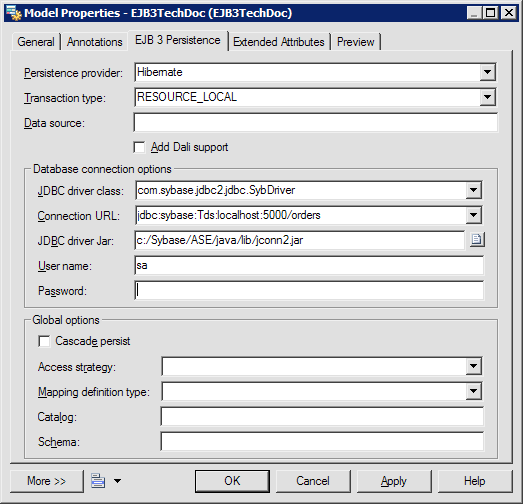

Chapter 9 Generating Persistent Objects for Java and JSF Pages
There are some persistence properties which are used for database connection. You need to set them before run the generated application.
![]() To define EJB 3 persistence configuration parameters:
To define EJB 3 persistence configuration parameters:

| Option | Description |
|---|---|
| Persistence provider | Specifies the persistence provider to be used. |
| Transaction type | Specifies the transaction type to be used. |
| Data source | Specifies the data source name (if data source is used). |
| Add Dali support | Specifies that the generated project can be authored in Dali. A special Eclipse project builder and nature will be generated. |
| JDBC driver class | Specifies the JDBC driver class. |
| Connection URL | Specifies the JDBC connection URL string. |
| JDBC driver jar | Specifies the JDBC driver jar file path. |
| User name | Specifies the database user name. |
| Password | Specifies the database user password. |
| Cascade persist | Specifies whether to set the cascade style to PERSIST for all relationships in the persistent unit. |
You can verify the configuration parameters in the Preview tab. The generated persistence configuration file looks like:
<persistence xmlns="http://java.sun.com/xml/ns/persistence"
xmlns:xsi="http://www.w3.org/2001/XMLSchema-instance"
xsi:schemaLocation="http://java.sun.com/xml/ns/persistence
http://java.sun.com/xml/ns/persistence/persistence_1_0.xsd"
version="1.0">
<persistence-unit name="EJB3_0Model" transaction-type="RESOURCE_LOCAL">
<description>
This is auto generated configuration for persistent unit EJB3_0Model
</description>
<provider>org.hibernate.ejb.HibernatePersistence</provider>
<!-- mapped files -->
<!--jar-file/-->
<!-- mapped classes -->
<class>com.company.orders.Customer</class>
<class>com.company.orders.Order</class>
<properties>
<property name="hibernate.dialect">org.hibernate.dialect.SybaseDialect</property>
<property name="hibernate.connection.driver_class">com.sybase.jdbc2.jdbc.SybDriver</property>
<property name="hibernate.connection.url">jdbc:sybase:Tds:localhost:5000/Production</property>
<property name="hibernate.connection.username">sa</property>
<property name="hibernate.connection.password"></property>
</properties>
</persistence-unit>
</persistence>
| Copyright (C) 2007. Sybase Inc. All rights reserved. |

| |